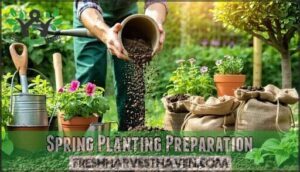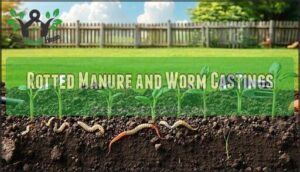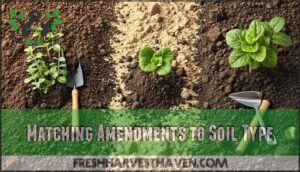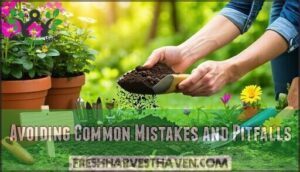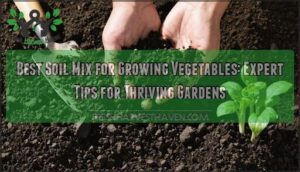This site is supported by our readers. We may earn a commission, at no cost to you, if you purchase through links.
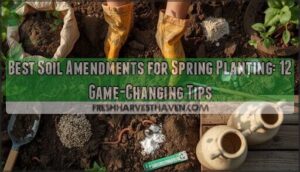
Start with compost 2-3 weeks before planting – it’s like giving your soil a nutritious breakfast that feeds plants all season.
Add nitrogen-rich blood meal for vegetables, bone meal for root crops, and perlite for drainage in heavy clay.
Wait until soil temperature hits 50°F consistently before working amendments in.
Don’t forget pH adjusters like lime for alkaline-loving plants or sulfur for acid lovers.
The secret most gardeners miss involves timing these applications with soil microbial activity for maximum nutrient uptake.
Table Of Contents
- Key Takeaways
- Choosing Soil Amendments
- Spring Planting Preparation
- Organic Soil Amendment Options
- Mineral Based Soil Amendments
- Sustainable Gardening Practices
- Soil Amendment Application Tips
- Frequently Asked Questions (FAQs)
- Is your garden ready for spring planting?
- How do you prepare soil for spring?
- How to plant a cover crop before spring?
- How do you make a good garden soil?
- Do raised beds need soil amendments?
- Why should you prepare your soil for spring?
- How do you amend soil for spring planting?
- What is the best material to amend soil?
- How do you prepare soil for spring planting?
- What time of year should I amend soil?
- Conclusion
Key Takeaways
- Test your soil first so you know exactly which amendments to use for your plants’ needs.
- Add compost 2-3 weeks before planting to boost nutrients, improve structure, and feed soil microbes.
- Match amendments like bone meal, blood meal, or perlite to your specific crops and soil type for best results.
- Wait until soil temperature hits 50°F and the soil crumbles easily before working in amendments to avoid compaction.
Choosing Soil Amendments
Choosing the right soil amendments isn’t guesswork—it’s about matching your plants’ specific needs with what your soil lacks.
You’ll want to test your soil first, then select amendments based on whether you’re growing heavy feeders like tomatoes or light feeders like herbs.
Plant Type and Amendment Selection
Success in spring planting starts with smart crop selection and matching the right amendments to your plants’ needs.
Think of soil amendments as vitamins for your garden—each plant type craves different nutrients for peak performance.
Here’s your plant-specific amendment roadmap:
- Vegetables thrive with nitrogen-rich composted manure or blood meal for robust leafy growth and maximum yields
- Flowering annuals need well-draining amendments like pine bark fines mixed with compost for maximum root development
- Acid-loving plants require peat moss or sulfur to lower soil pH and release nutrient availability
- Container gardens benefit from perlite and vermiculite blends that balance moisture retention with proper drainage
- Root vegetables perform best with bone meal additions that boost phosphorus for strong underground development
Start with soil testing to identify deficiencies, then select organic amendments that address your garden’s specific needs.
Amendment mixing lets you create custom blends—like combining compost with rock phosphate for balanced plant nutrition.
Smart garden planning means understanding that different plants have unique requirements, and soil fertility depends on matching these needs perfectly.
For optimal results, consider using organic soil amendments to enhance your garden’s overall health and productivity.
Application Methods and Timing
Perfect timing makes all the difference when applying soil amendments for spring planting.
Timing your soil prep beats rushing into planting every single time
You’ll want to start your soil preparation 2-3 weeks before planting, giving organic materials time to integrate properly.
This window allows compost and other amendments to settle without shocking your plants.
Application Method Best Timing
Check your soil’s readiness first—it should crumble like chocolate cake crumbs, not stick together like modeling clay.
Working soggy soil creates concrete-hard clumps that’ll haunt you all season.
Mix amendments 6-8 inches deep for proper soil mixing and nutrient distribution.
Your spring preparation patience pays off when plants thrive in well-amended, properly timed soil.
Spring Planting Preparation
Spring’s thaw reveals the truth about your soil’s winter struggles, making early preparation essential for successful planting.
You’ll want to start soil amendments 2-4 weeks before your last frost date to give organic matter time to integrate and microbial activity to resume.
Seasonal Soil Considerations
Winter leaves your soil facing real challenges that need addressing before spring planting begins.
Winter’s harsh grip leaves your soil compacted, nutrient-depleted, and crying out for spring revival
Cold weather creates compacted layers, while precipitation leaches essential nutrients from your garden beds.
Here’s what to tackle for healthy Soil Health:
- Check Soil Temperature – Wait until it reaches 50°F consistently for ideal Spring Planting
- Assess Winter Mulch damage and remove excess that blocks Spring Aeration**
- Test for Soil Erosion** by examining exposed root systems or drainage patterns
- Add Compost and Soil Amendments now for Frost Protection** and nutrient restoration
To prevent soil degradation, consider using techniques for soil moisture retention to support healthy plant growth.
Start your Organic Gardening prep early – your soil needs time to recover from winter’s grip.
Amendment Strategies for Spring
Timing your soil amendments correctly can make or break your garden’s success. Start with Soil Testing to identify what your soil actually needs—it’s like getting a health checkup before starting a fitness routine.
Apply amendments when soil crumbles rather than forms muddy clumps. This sweet spot guarantees proper Soil Aeration and prevents compaction that’ll haunt you all season.
| Amendment Type | Best Application Time |
|---|---|
| Compost & Worm Castings | 2-3 weeks before planting |
| Spring Fertilizers | Just before seed sowing |
| Lime or sulfur | 6-8 weeks before planting |
Focus your strategy on Garden Renewal through Organic Gardening practices. Work these Soil Amendments into the top 6-8 inches for maximum impact. Consider Crop Rotation when planning your Spring Planting—don’t plant tomatoes where last year’s peppers grew.
Plant Selection for Optimal Growth
Your soil amendments have prepared the groundwork, but choosing the right plants maximizes your spring success.
Start with Seed Selection that matches your hardiness zone and Soil Compatibility—some vegetables thrive in compost-rich beds while others prefer leaner conditions.
Plant Diversity creates natural pest control and nutrient cycling. Consider Growth Patterns when spacing: tall tomatoes shouldn’t shade lettuce.
Crop Rotation prevents nutrient depletion—follow heavy feeders like corn with nitrogen-fixing beans.
Smart plant choices turn your organic matter investments into garden gold, creating thriving soil health that feeds itself year after year.
Organic Soil Amendment Options
When you’re prepping your garden beds for spring planting, organic amendments are your soil’s best friends.
These natural powerhouses don’t just feed your plants—they transform your dirt into a living ecosystem that’ll have your vegetables practically jumping out of the ground.
Compost and Its Benefits
Think of compost as your soil’s best friend—it’s the Swiss Army knife of organic amendments that tackles multiple garden challenges at once.
This decomposed organic matter doesn’t just feed your plants; it transforms your entire soil ecosystem from the ground up.
Here’s what makes compost so powerful for spring gardens:
- Increases water retention by 250%, helping sandy soils hold moisture while improving drainage in heavy clay
- Boosts soil microbes and nutrient cycling, creating a living network that feeds plants naturally
- Reduces fertilizer needs by 75%, as compost provides slow-release organic fertilizer that won’t burn roots
- Enhances carbon sequestration, storing atmospheric carbon in your soil for years
- Improves soil structure, creating air pockets that roots love while supporting beneficial organisms
Whether you’re brewing compost tea for a liquid boost or mixing in leaf mold for extra organic matter, compost adapts to your garden’s specific needs.
It’s like having a personal soil therapist that never takes a day off.
Compost applications often involve compost tea benefits that can be used to create a balanced soil ecosystem.
Rotted Manure and Worm Castings
Applying well-aged manure benefits and worm castings transforms your garden’s nutrient profile dramatically. Rotted manure acts like a slow-release organic fertilizer, delivering nitrogen, phosphorus, and potassium over twelve months while boosting microbial activity through its fibrous texture.
You’ll need manure aged at least six months to prevent root burn—fresh stuff’s too hot for tender seedlings. Worm castings offer premium soil enrichment without overwhelming young plants.
These nutrient-dense pellets increase water retention by 25% and feed beneficial soil organisms that break down organic matter. Unlike synthetic fertilizers, castings won’t shock your plants with sudden nutrient spikes.
Mix both amendments into beds 2-3 weeks before spring planting. Apply two inches of rotted manure and one inch of worm castings per square foot, working them 6-8 inches deep for ideal root contact.
For best results, understanding manure fertilizer benefits is essential to creating a balanced soil ecosystem.
Peat Moss and Coconut Coir Alternatives
While compost and worm castings work wonders, you’ll want moisture-retaining amendments that won’t destroy fragile ecosystems.
Traditional peat moss harvesting devastates wetlands, but modern sphagnum replacements offer better alternatives.
Coconut coir leads the pack as your go-to sustainable choice. This fibrous material holds water like a sponge while maintaining proper drainage – think of it as nature’s perfect balance between wet and dry.
Unlike bark chips or straw mulch that decompose quickly, coco coir lasts multiple growing seasons.
Here’s why coconut coir beats other organic amendments:
- Water retention – absorbs 10 times its weight without waterlogging roots
- Disease resistance – natural antifungal properties protect seedlings
- pH stability – maintains neutral 6.0-6.8 range most plants love
- Eco-friendly – repurposes coconut processing waste instead of mining bogs
Mix coconut coir with compost tea, leaf mold, or perlite for custom soil blends. You’ll get the moisture control of peat moss without the environmental guilt.
Mineral Based Soil Amendments
While organic amendments feed your soil’s biology, mineral-based amendments tackle the structural and chemical challenges that can make or break your spring garden.
These rock-solid helpers work like soil mechanics, adjusting pH levels, opening up compacted earth, and delivering targeted nutrients that plants can access for months, acting as mineral-based amendments.
Gypsum and Lime for PH Adjustment
While organic amendments build long-term soil health, mineral-based solutions tackle immediate pH problems head-on.
Lime Uses are straightforward—it raises soil pH in acidic soils by neutralizing excess hydrogen ions.
Agricultural limestone works like nature’s antacid, gradually releasing calcium carbonate to boost pH levels from problematic 5.5 readings to plant-friendly 6.5-7.0 ranges.
Gypsum Benefits tell a different story.
This calcium sulfate superstar improves clay soil structure without touching your Soil PH—think of it as a soil conditioner, not a pH adjuster.
Gypsum breaks up compacted clay while adding essential calcium and sulfur.
Here’s your game plan: test first, then act.
Acidic Soils need lime at 2-5 pounds per 100 square feet for Alkaline Correction.
Clay problems? Gypsum at 1-2 pounds per 100 square feet works wonders without pH drama.
Skip the guesswork—Lime changes everything chemically, while Gypsum improves structure.
Know which problem you’re solving before you start amending.
Perlite and Vermiculite for Drainage
While pH adjustments lay the groundwork, proper drainage solutions can make or break your spring garden.
Two volcanic minerals offer distinct advantages for soil structure improvement.
Perlite acts like nature’s styrofoam, creating essential air pockets that boost soil aeration and prevent waterlogged roots.
Its white, popcorn-like chunks work wonders in heavy clay soils where porosity improvement matters most.
Vermiculite takes a different approach, balancing water retention with drainage like a microscopic sponge.
This accordion-like mineral expands to hold moisture while maintaining proper airflow, making it perfect for sandy soils that drain too quickly.
Here’s your drainage game plan:
- Mix 10-20% perlite into clay soils for maximum aeration benefits
- Use vermiculite in sandy conditions where moisture control is priority
- Combine both soil amendments for the ultimate drainage-retention balance
These volcanic helpers transform stubborn, compacted earth into the perfect growing medium your spring plants crave.
For best results, understanding perlite soil benefits is essential to creating a well-balanced garden ecosystem.
Rock Phosphate for Nutrient Boost
Rock phosphate stands as your garden’s secret weapon for long-term soil fertility and vigorous root development. This natural mineral amendment delivers slow-release phosphorus that feeds your plants for up to five years, unlike synthetic fertilizers that disappear after spring rains.
Rock phosphate excels at nutrient cycling while maintaining healthy pH levels, making it perfect for spring planting preparations. Here’s how to harness this powerhouse amendment:
- Apply 10 pounds per 100 square feet before your planting season kicks off
- Mix thoroughly into the top 6 inches where beneficial mycorrhizal fungi enhance mineral uptake
- Combine with compost to boost organic acids that release phosphorus stores naturally
Smart gardeners know that rock phosphate’s marine origins create an excellent organic choice for sustainable nutrient uptake. This soil amendment continues releasing essential phosphorus sources season after season, supporting everything from carrots to cosmos while building lasting soil fertility that synthetic fertilizer simply can’t match. Effective soil improvement methods are vital for maximizing the benefits of rock phosphate and other natural amendments.
Sustainable Gardening Practices
You’ll transform your garden into a sustainable powerhouse by adopting circular practices that work with nature’s rhythms.
These earth-friendly approaches boost your plants’ health as well as reduce waste and create a self-sustaining ecosystem that’ll make your neighbor’s lawn look like a wasteland.
Creating a Circular Ecosystem
Your garden’s circular economy starts with viewing "waste" as tomorrow’s treasure. Transform scraps into soil gold while cutting your environmental footprint through smart waste reduction strategies.
Build your eco friendly system with these sustainable living practices:
- Convert kitchen scraps and yard debris into nutrient-rich compost that supercharges soil health
- Layer fallen leaves as natural mulch that feeds beneficial microorganisms and improves soil regeneration
- Practice companion planting to naturally cycle nutrients while supporting biodiversity
This circular economy approach eliminates waste streams while building organic matter reserves. Your soil amendments become self-generating through natural processes, creating a regenerative cycle that strengthens year after year.
By adopting low maintenance organic gardening techniques, you can create a thriving ecosystem that requires minimal external inputs.
Organic Certification and Benefits
Making the switch to certified amendments can feel like upgrading from a basic toolkit to professional-grade equipment.
When you invest in Organic Labels, you’re getting more than just marketing—you’re accessing three years of verified Sustainable Farming practices that transform soil ecosystems.
Organic Amendments deliver measurable results that conventional products simply can’t match:
- Premium market access connects you with Eco Friendly suppliers and specialized Organic Gardening Methods communities
- Verified quality through rigorous testing guarantees your Natural Fertilizers meet strict environmental standards
- Enhanced Soil Health backed by scientific research showing doubled organic matter levels in long-term studies
- Environmental stewardship through Green Practices that reduce chemical runoff and support biodiversity
- Long-term value as certified Compost and Worm Castings build resilient soil ecosystems over multiple seasons
Sure, certified amendments cost more upfront, but they’re an investment in proven results.
You’re not just buying soil conditioners—you’re choosing sustainable methods that deliver consistent, measurable improvements to your garden’s foundation.
Reducing Environmental Impact
Beyond organic certification, you can slash your garden’s environmental footprint with smart choices.
Swap peat moss for coconut coir and other green alternatives – your wallet and wetlands will thank you.
Compost kitchen scraps instead of trashing them, creating gold for your soil while practicing environmental conservation.
Biodegradable options like natural polymers retain moisture without harming beneficial microbes.
Biochar locks carbon underground for decades while boosting plant health.
Worm castings from backyard bins eliminate plastic packaging waste.
These sustainable gardening practices prove environmental sustainability doesn’t require sacrifice.
Mycorrhizal fungi inoculants create thriving root networks naturally.
Your eco friendly choices ripple outward, protecting ecosystems while growing healthier plants through proven sustainable practices and organic amendments.
Soil Amendment Application Tips
You’ve learned the basics of soil amendments, but applying them correctly separates novice gardeners from pros who see dramatic plant growth.
These three application strategies will help you avoid costly mistakes and maximize your spring garden’s potential.
Matching Amendments to Soil Type
Every successful gardener knows that soil testing reveals the foundation for proper amendment selection.
Your soil type determines which amendments will work best and which ones might actually harm your plants.
Clay soils struggle with drainage and compaction, so they need organic matter like compost combined with gypsum to break up heavy particles.
Sandy loams drain too quickly and can’t hold nutrients, requiring moisture-retaining amendments like aged manure or peat replacements such as coconut coir.
Test your soil pH first—it’s your roadmap for choosing the right amendments.
Here’s your amendment matching guide:
- Clay soils – Mix compost with perlite to improve drainage and reduce compaction
- Sandy loams – Add worm castings or aged manure for better water and nutrient retention
- Balanced loam – Light applications of compost maintain ideal structure without overwhelming existing balance
Understanding soil pH levels is vital for selecting the most effective amendments for your garden.
Match your amendment types to your specific soil challenges, and you’ll see dramatically better spring results.
Avoiding Common Mistakes and Pitfalls
Although soil amendments are beneficial, timing and application mistakes can derail your spring planting success.
Over Amendment creates nutrient imbalance that stunts growth rather than helping it.
Soil Testing prevents guesswork—skipping it leads to pH correction nightmares and wasted money.
Poor Mixing leaves concentrated pockets that burn delicate roots.
Bad Timing means nutrients leach away before plants need them.
Test first, measure carefully, mix thoroughly, and allow proper integration time for healthy soil amendments.
Scaling Strategies for Large Gardens
While smaller plots let you fine-tune every detail, Garden Expansion requires strategic thinking for effective Soil Optimization.
Large Scale operations need smart approaches that won’t overwhelm your resources during Spring Planting season.
Transform your garden soil efficiently with these proven strategies:
- Bulk purchasing and mechanical distribution – Order Soil Amendments by the cubic yard and use broadcast spreaders for consistent Organic Matter coverage across your property.
- Strategic Compost stations – Establish multiple composting areas throughout your garden for continuous soil enrichment without hauling materials long distances.
- Systematic Space Management – Implement Crop Rotation zones that allow targeted amendment applications based on seasonal planting needs.
Frequently Asked Questions (FAQs)
Is your garden ready for spring planting?
Adding 2-5% organic matter through compost can transform your soil in just one season.
You’ll need to test pH levels first and incorporate amendments 6-8 inches deep before planting begins, which involves incorporate amendments 6-8 inches deep to prepare the soil properly.
How do you prepare soil for spring?
Test your soil’s pH and drainage first.
Then work in 2-4 inches of compost to boost nutrients and structure.
Add bone meal for phosphorus, especially around new plantings.
Till amendments 6-8 inches deep for best results.
How to plant a cover crop before spring?
Plant cover crops in late fall, about 6-8 weeks before your first hard frost.
Choose cold-hardy varieties like winter rye or crimson clover that’ll grow through winter, then till them under in early spring before planting.
How do you make a good garden soil?
Ready to grow something amazing?
Start with a soil test to identify what’s missing, then add compost for nutrients, perlite for drainage, and organic matter like leaf mold to create the perfect foundation for thriving plants.
Do raised beds need soil amendments?
Yes, raised beds absolutely need soil amendments.
You’ll want to enhance that fresh soil mix with compost, aged manure, or other organic matter to boost fertility, improve drainage, and create the thriving growing environment your plants crave.
Why should you prepare your soil for spring?
Springtime soil preparation supercharges your garden’s growing potential.
Winter freezes compact earth, depleting nutrients and reducing drainage.
Amending soil now boosts microbial activity, enhances root development, and guarantees your plants get maximum nutrition throughout the growing season, which is crucial for maximum nutrition.
How do you amend soil for spring planting?
Start by testing your soil’s pH and nutrient levels using a simple kit.
Mix compost six inches deep throughout your planting area, then add bone meal for phosphorus and well-rotted manure for nitrogen.
What is the best material to amend soil?
Compost stands out as the ultimate soil amendment because it delivers nutrients, improves structure, and boosts beneficial microorganisms all in one package, making it your garden’s best friend.
How do you prepare soil for spring planting?
Like a gardener awakening from winter’s slumber, you’ll test soil pH first.
Then incorporate compost and organic matter six inches deep, ensuring proper drainage and nutrient balance for robust spring growth.
What time of year should I amend soil?
You can amend your soil year-round, but fall’s the sweet spot for most amendments. Spring works great for quick-acting organic matter like compost before planting season kicks off.
Conclusion
Transforming your garden into a thriving ecosystem starts with mastering the best soil amendments for spring planting.
You’ve learned how timing, plant-specific nutrients, and microbial activity create the foundation for exceptional growth.
Whether you’re working clay, sand, or loam, these twelve strategies give you the tools to nurture healthier plants and maximize yields.
Remember, healthy soil equals healthy plants—it’s that simple.
Start small, observe results, and expand your amendment program gradually.
Your spring garden awaits this transformation.
- https://www.digicomply.com/blog/organic-certification
- https://nfccertification.com/the-benefits-of-organic-food-certification
- https://www.ams.usda.gov/services/organic-certification/benefits
- https://www.soilassociation.org/take-action/organic-living/why-organic
- https://agriculture.institute/organic-produce-inspection-certification/benefits-organic-certification-farmers-consumers

